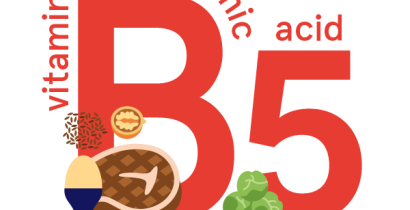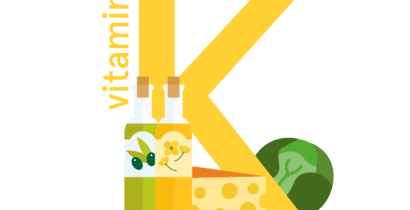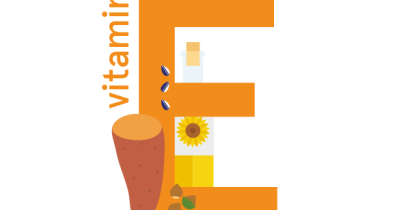Vitamin C: foods, functions, how much do you need & more
Last Updated : 11 January 2021Vitamin C is one of the most popular vitamins, particularly during the flu season. While this vitamin won’t necessarily cure your colds, it’s an important one to keep the healthy function of your immune system!
What is vitamin C?
Vitamin C, also known as ascorbic acid, is a water-soluble vitamin found in a variety of foods.
What are the functions of vitamin C?
Vitamin C is involved in many bodily reactions, from protecting our cells against damage caused by free radicals to supporting our immune response and helping our bodies produce energy.
Vitamin C is also needed to produce collagen, a protein that forms and keeps the structure of many of our bodily tissues (such as our skin, bones, teeth, blood vessels, tendons, etc). Plus, it helps our bodies make key hormones and neurotransmitters that keep the healthy functioning of our brain and nervous system.
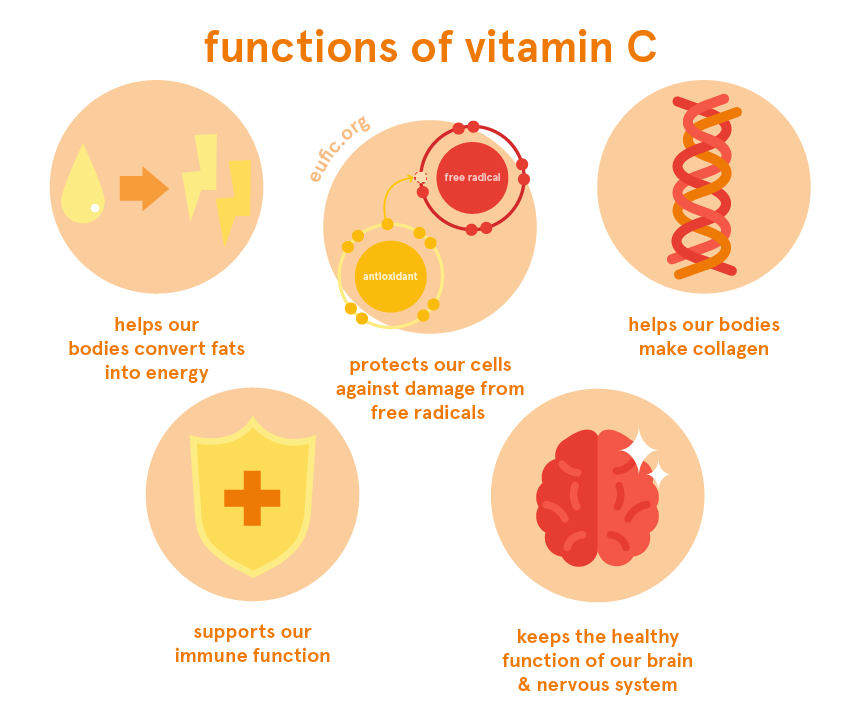
How much vitamin C do I need per day?
How much vitamin C you need per day changes according to your age, sex and life-stage.
The dietary reference value (DRV) for healthy adults (over the age of 18) is between 95-110 mg of vitamin C per day. During pregnancy and lactation, needs can go up to 105 mg and 155 mg of vitamin C per day, respectively.
We can get enough vitamin C from our diets by eating a variety of foods. Following your country's dietary guidelines on a healthy and balanced diet will help you meet your needs for vitamin C.
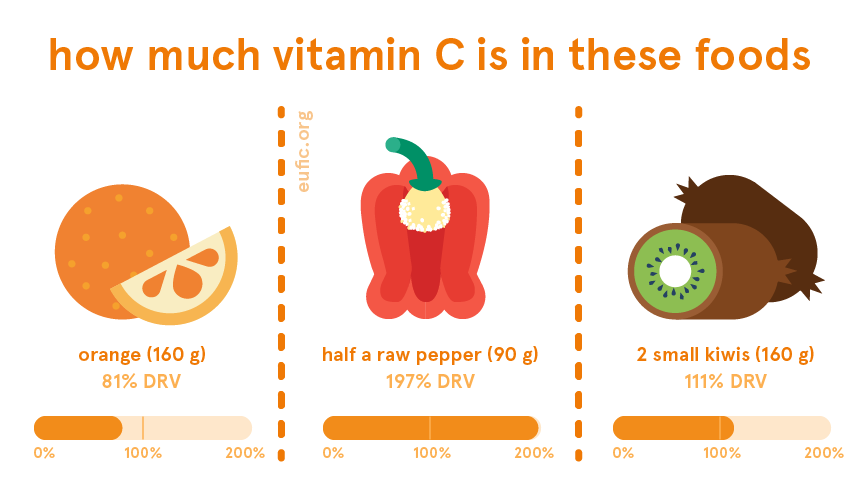
* These values are based on the population reference intake (PRI) estimates from European Food Safety Authority (EFSA). They should not be interpreted as nutrient goals. To know more about DRVs in Europe click here.
What foods contain vitamin C?
We can find vitamin C in a variety of foods, but some of its richest sources include:
- fruits (such as berries, lychee, papaya, kiwi and citrus fruits)
- vegetables (such as cauliflower, cabbage and sweet pepper).
Usually, meat and fish don’t have much vitamin C, but kidney and liver are two good animal sources of this vitamin.
Some herbs and spices (parsley, sorrel and chives) are also rich in vitamin C; however, they don’t really increase our intake of this vitamin because we only eat them in very small amounts.
While vitamin C is particularly high in fruits and vegetables, the amount of this vitamin in plant foods varies depending on factors such as the plants’ growing conditions, type of soil, season of harvesting, transport and shelf time prior to use.
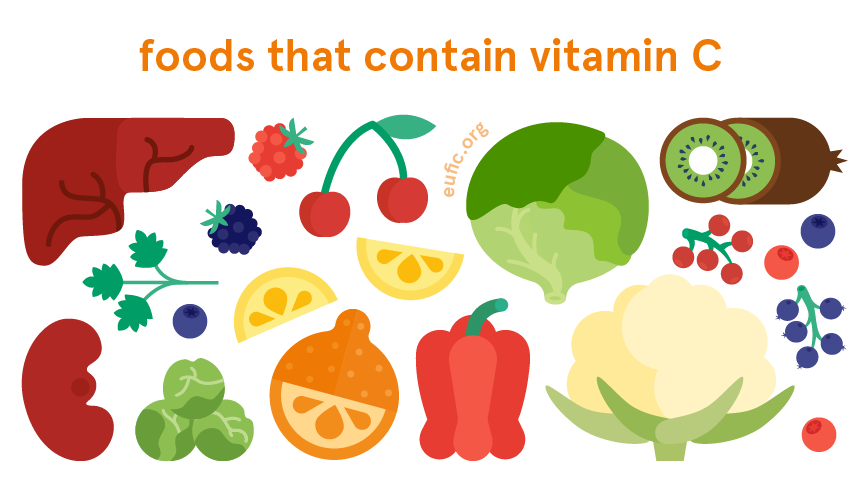
Does vitamin C interact with other nutrients?
Vitamin C can help our bodies absorb more iron from plant-based foods (non-haeme iron) which is less absorbed than iron from animal sources (haeme iron). This effect is also dependent on other factors like the iron levels in our bodies or the make-up of the meal (for example, other nutrients or compounds in foods, such as calcium or compounds in tea, can counteract this effect by impairing iron absorption). Nevertheless, get the best of this combination by matching iron-rich foods with sources of vitamin C. For example, add raw peppers to your lentil salad or have a glass of orange juice with your fortified breakfast cereals!
Vitamin C and vitamin E often join forces in their antioxidant roles. When vitamin E neutralises a free radical, it loses its antioxidant properties, which can be regenerated with the help of vitamin C. Good levels of both these vitamins are particularly important for those who smoke, as they are more prone to form higher amounts of free radicals in the body.
What happens if I have too little vitamin C?
Vitamin C deficiency is rare in developed countries since most people get the recommended amounts of this vitamin from the diet.
Vitamin C deficiency can cause fatigue, anaemia, joint pain and muscle weakness. If maintained over time, severe vitamin C deficiency can evolve to scurvy, a condition that affects our bodies’ ability to produce collagen causing tooth loss, joint pain, gum inflammation and bleeding, bruises and poor wound healing. In children, a lack of vitamin C can cause malformations in the bones.
What happens if I have too much vitamin C?
Vitamin C is not considered harmful and it’s unlikely that we get too much of it from foods alone.
However, having 3-4 times more than the DRV (about 3-4g) can upset our stomach and gut, causing, for example, diarrhoea. Moreover, there’s no evidence for an increased intake of vitamin C beyond the recommendation to result in any health benefits or consequences in healthy people.
Before taking vitamin C supplements, check with your doctor or a registered dietitian/nutritionist or consult your national dietary guideline.
When should I pay extra attention to my vitamin C intake?
Vitamin C deficiency is not a risk for the general population since most people can get the recommended amounts of this vitamin from a varied and balanced diet.
Despite vitamin C being popularly linked with preventing or treating the common cold, healthy and well-nourished people don’t seem to get any health benefits from having larger amounts of this vitamin from foods or supplements. The best way to keep the normal function of our immune system is to consistently meet the recommended amounts for all vitamins and minerals.
References
- European Food Safety Authority. 2013. Scientific Opinion on Dietary Reference Values for vitamin C. EFSA Journal 2013;11(11):3418
- World Health Organization (WHO). 2004. Vitamin and mineral requirements in human nutrition. 2nd edition. Geneva, Switzerland: WHO.
- Public Health England. 2019. McCance and Widdowson’s Composition of Foods Integrated Dataset.
